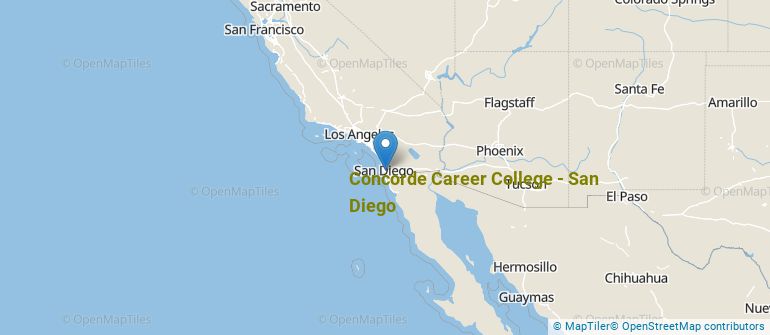 by our College Data Analytics Team
by our College Data Analytics TeamExplore the best ranked schools for the programs you are most interested in.
Concorde Career College - San Diego was not ranked in College Factual's 2025 Best Overall Colleges report. This could be for a number of reasons, including lack of data.
See all of the rankings for Concorde Career College - San Diego.
With an acceptance rate of 96%, Concorde Career College - San Diego is easier to get into than many other schools. But that doesn't mean you can slack off on your application. Make sure to treat this school like any other when submitting requested materials and documents.
The student to faculty ratio at Concorde Career College - San Diego is 22 to 1, which is high when compared to the national average of 15 to 1. This may indicate that some of your classes will be larger in size than they would be at other schools. However, upper level classes will probably be smaller.
When estimating how much access students will have to their teachers, some people like to look at what percentage of faculty members are full time. This is because part-time teachers may not have as much time to spend on campus as their full-time counterparts.
The full-time faculty percentage at Concorde Career College - San Diego is 58%. This is higher than the national average of 47%.
Concorde Career College - San Diego has a freshmen retention rate of 78%. That's a good sign that full-time students like the school and their professors enough to want to stick around for another year. It's also a sign that the admissions team did a good job in choosing applicants who were a good fit for the school.
During the 2017-2018 academic year, there were 733 undergraduates at Concorde Career College - San Diego with 714 being full-time and 19 being part-time.
| $0-30 K | $30K-48K | $48-75 | $75-110K | $110K + |
|---|---|---|---|---|
| $24,355 | $22,998 | $25,950 | $26,656 | $26,958 |
The net price is calculated by adding tuition, room, board and other costs and subtracting financial aid.Note that the net price is typically less than the published for a school. For more information on the sticker price of Concorde Career College - San Diego, see our tuition and fees and room and board pages.
While almost two-thirds of students nationwide take out loans to pay for college, the percentage may be quite different for the school you plan on attending. At Concorde Career College - San Diego, approximately 71% of students took out student loans averaging $7,920 a year. That adds up to $31,680 over four years for those students.
Get more details about paying for Concorde Career College - San Diego.

See which majors at Concorde Career College - San Diego make the most money.
Get more details about the location of Concorde Career College - San Diego.

Contact details for Concorde Career College - San Diego are given below.
| Contact Details | |
|---|---|
| Address: | 4393 Imperial Avenue, Suite 100, San Diego, CA 92113-1964 |
| Phone: | 619-688-0800 |
| Website: | https://www.concorde.edu/campus/san-diego-california |
| Most Popular Majors | Bachelor’s Degrees | Average Salary of Graduates |
|---|---|---|
| Allied Health & Medical Assisting Services | 198 | NA |
| Dental Support Services | 157 | NA |
| Practical Nursing & Nursing Assistants | 90 | NA |
| Allied Health Professions | 26 | NA |
| Health & Medical Administrative Services | 24 | NA |
Online courses area a great option for busy, working students as well as for those who have scheduling conflicts and want to study on their own time. As time goes by, expect to see more and more online learning options become available.
In 2022-2023, 730 students took at least one online class at Concorde Career College - San Diego. This is a decrease from the 735 students who took online classes the previous year.
| Year | Took at Least One Online Class | Took All Classes Online |
|---|---|---|
| 2022-2023 | 730 | 0 |
| 2021-2022 | 735 | 0 |
| 2020-2021 | 94 | 0 |
| 2018-2019 | 0 | 0 |
Learn more about online learning at Concorde Career College - San Diego.
Footnotes
*The racial-ethnic minorities count is calculated by taking the total number of students and subtracting white students, international students, and students whose race/ethnicity was unknown. This number is then divided by the total number of students at the school to obtain the racial-ethnic minorities percentage.
References
More about our data sources and methodologies.